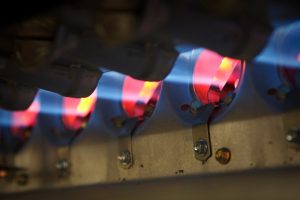 Do you have a gas-powered furnace in your home? We wouldn’t be surprised if you do. It is, after all, the most popular heating system found in homes throughout the country, particularly in areas like ours that get significantly colder than other states during the winter.
Do you have a gas-powered furnace in your home? We wouldn’t be surprised if you do. It is, after all, the most popular heating system found in homes throughout the country, particularly in areas like ours that get significantly colder than other states during the winter.
Furnaces are cost-effective, and a great choice for most homeowners. But, while they are not dangerous in nature, when you use natural gas in your home you do run the risk of toxic gas leaks and combustion problems. The main concern in avoiding this is taking good care of the heat exchangers.
A cracked heat exchanger in your furnace is never something you should ignore. If you suspect you have one or have been told you have one, please be sure to shut off your heater and call for Coeur d’Alene, ID heating services ASAP.
“What Is a Heat Exchanger, Though?”
Good question! This is the component that applies heat to the air which your blower fan sends into the ventilation system (and then, into your home). It’s clam-shell shaped metal chamber, and a number of them are arranged in rows in the furnace system. This is where hot combustion gas from the burners collects.
The intense heat from the gas raises the temperature of the metal walls, making the outside of the heat exchanger extremely hot. This allows the furnace to apply the heat of the combustion gas to the air without letting those gases get into contact with the air.
“What Causes Cracks in Heat Exchangers?”
The heat exchangers in your furnace undergo a large amount of strain throughout the winter and throughout the years. Each time they heat up, the metal expands. Over time, this constant expansion and contraction weakens the metal, leading to eventual corrosion.
This is, naturally, a higher risk in older furnaces, and/or furnaces that don’t vent as well as they should or are not well maintained. Corrosion weakens the metal even further, and this added stress on the heat exchangers leads to small cracks that may be virtually invisible to the naked eye, but creates major issues for health and safety.
Cracked Heat Exchangers and the Danger They Pose
As we alluded to above, a crack on a heat exchanger can be invisible to you. In fact, you could pour water into a cooled, cracked heat exchanger and probably not even see a drop of water come out of it. But, what happens is that when this component heats up, the cracks widen and this allows unhealthy gases escape into your living space that would have otherwise been vented into the flue.
This gas is known as CO (carbon monoxide) and when you’re exposed to too much of it, you may experience nausea, dizziness, lightheadedness, and more. CO exposure can and has been fatal, which is why we really can’t understate the danger of a cracked heat exchanger.
The quickest and easiest way to protect your family against this, aside from keeping up on furnace maintenance, is to have carbon monoxide detectors installed. If your carbon monoxide detectors detect gas in the home, be sure to open all your windows, vacate the premises, and call emergency services right away.
